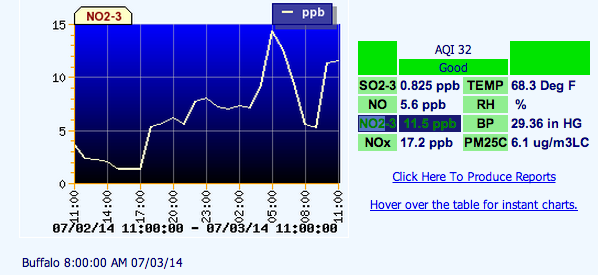Jul 3
2014
Air quality in Buffalo is improving

Less than 10 years ago the Buffalo region’s nitrogen dioxide levels were on par with larger cities such as Los Angeles, Phoenix, New York and Denver.
But the region’s smog has diminished quite a bit since then, including steep drops in nitrogen dioxide.
The gas is one of numerous air pollutants that can agitate asthma, a respiratory disease that plagues neighborhoods in both east and west Buffalo, especially near the Peace Bridge.
“The gas is produced primarily during the combustion of gasoline in vehicle engines and coal in power plants,” according to NASA. “It’s also a good proxy for the presence of air pollution in general.”
To illustrate the national decline, NASA has new maps and animations on its website. This animation presents changes in levels in the Northeast air from 2005 to 2011. The Buffalo-Niagara region goes from red to an orangish-yellow in the animation, which means the concentrations have dropped.
For the technical air pollution geeks, the state Department of Environmental Conservation’s air monitoring website has hour-to-hour measurements from the Buffalo monitor on Dingens Street. The graph below shows Buffalo’s reading as of 8 a.m. Thursday morning:
For 43 years the federal air quality standard for nitrogen dioxide pollution stood untouched—a rule that the American Lung Association said failed “to protect the health of children, older adults and people with asthma and of people who live and work near major highways.”
As more science verified the those concerns, the Environmental Protection Agency in 2010 instituted a daily maximum one-hour standard for nitrogen dioxide at 100 parts per billion (ppb) averaged over three years. It’s important to note that the EPA’s final review of the standard concluded that scientific evidence strongly supported a level below what ended up getting approved.
Regardless, the Buffalo region is in attainment with this federal standard.
But not too long ago the region was close to violating the standard.
DEC data shows that from 2007 to 2009, the Buffalo air monitor’s nitrogen dioxide reading averaged 86 ppb. That was 16 to 22 percent higher than levels in parts of New York City, including the Bronx. At the time, that was among the highest in the nation.
Since then, the levels have continued to fall, as shown in the graph below for 2013:
Why the drop?
According to NASA, “air pollution has decreased even though population and the number of cars on the roads have increased. The shift is the result of regulations, technology improvements and economic changes, scientists say.”
Locally, there have been some major economic changes. For example, two coal plants in the region—Huntley in Tonawanda and Somerset in Niagara County—are running well below capacity, which means they belch far less pollutants. The Huntley plant is at risk of closing, like many coal plants across the country, and the Somerset plant emerged out of bankruptcy a few years ago.
Both plants have reported significant reductions in pollution emissions. For example, Huntley has reported a 65 percent drop in its greenhouse gas emissions since 2010, which includes nitrogen dioxide.


